Papers by Kostas Karamanis

For four decades OTE (Hellenic Telecommunication Organization) had operated as a state monopoly, ... more For four decades OTE (Hellenic Telecommunication Organization) had operated as a state monopoly, providing exclusively basic telecommunication services. However, this ownership status gave rise to much controversy. Not only the harmonization with the European Community legislation, but the poor performance of OTE as well, made the restructuring of the Organization necessary in order to achieve a smooth adaptation to the new conditions. OTE had to be transformed from a subscription based company to a client oriented one. The new strategy had to incorporate not only workforce which is efficient, well-informed and actively involved towards the aims of a competitive, decentralized and customer centered enterprise, but also the offer of a wider variety of services and products in a competitive price, combined with an aggressive commercial policy and a wide range of a dynamic sales network. Therefore, along with the first steps towards the privatization of OTE, the plans for its administrative restructuring were implemented. In the present article we examine the changes that took place regarding the administrative turnover and the labor relations of OTE since the early steps of its privatization. In addition, we examine the economic performance of OTE for a time period of 16 years (seven years before and nine years after its privatization) with the help of specific financial figures, such as profitability (net income/total assets), operating efficiency (net income/total number of employees), production, investments, dividends and leverage of the Organization. From the results it was found out that the economic performance of OTE deteriorates after the privatization. On the contrary, its financial figures show a significant improvement during the preprivatization period (1989)(1990)(1991)(1992)(1993)(1994)(1995).

Economics & Sociology, 2022
In this paper we investigate the trends in the number of employees by occupational category acros... more In this paper we investigate the trends in the number of employees by occupational category across the economy's main sectors. For the purpose of our study we use mixed-fixed and random coefficient modeling, taking unemployment, gross value added, employee compensation, and proxies for labor force participation rate as the determining factors. Using annual data from 2000 to 2018, we examine the effects of the determining factors on the share of workers by sector and occupation. Our econometric research shows that the regression coefficients vary between sectors and categories of occupation and the proposed model correctly estimates the dependent variable and the heterogeneous variation of the random effects. Our model can be used to identify occupations with current and future shortages across sectors as well as for assessment and anticipation of employment needs. This study's main contribution is the provision of a flexible and innovative econometric tool, with minimal data requirements, for investigating and assessing employment across economic activities over time. Moreover, in conjunction with other forecasting macroeconomic models, it can offer accurate forecasts for future levels and trends in employment.

Theoretical and Empirical Researches in Urban Management, Aug 1, 2019
This study analyses the satisfaction of workers from their working environment during the current... more This study analyses the satisfaction of workers from their working environment during the current financial crisis in Greece. As a case study, work satisfaction is examined among employees of the Region of Epirus, Greece who, on a daily basis, serve the needs of a large geographical region. In order to achieve this, we conducted an empirical research in 2018 using the Minnesota Satisfaction Questionnaire (MSQ) model. From the findings of this research and in accordance with those of other international surveys, we conclude that satisfaction from endogenous factors (e.g. activity, independence, creativity etc.) is higher than exogenous (e.g. human relations, remuneration, colleagues, working conditions etc.). In addition, the study of satisfaction per group of employees indicates that the Director/Office Manager and the University Educational employees appear more satisfied when it comes to satisfaction deriving from endogenous factors and more dissatisfied as far as indicators of exogenous satisfaction is concerned.
Springer proceedings in business and economics, 2022

The purpose of this paper is to investigate the perceptions of managers concerning the impact of ... more The purpose of this paper is to investigate the perceptions of managers concerning the impact of institutional liberalisation of telecommunication industry on market functioning and business growth. The empirical analysis is based on a survey of 44 telecommunication companies operating for the period 2001 to 2009 in the Greek economy. These are the most important firms of the specific industry. The findings indicate that liberalisation causes a substantial increase of competition between public and private companies. Price policy and marketing policy are the main competition factors. However, several barriers such as difficult access to infrastructure telecommunication networks for private entrants and not sufficient compliance of the state-owned dominant company with the rules of healthy competition hamper competition seriously. Overall, the managers of the sample firms reveal the evolution of the private sector and the new ‘business atmosphere’ in the Greek Telecommunication indus...
2022 7th South-East Europe Design Automation, Computer Engineering, Computer Networks and Social Media Conference (SEEDA-CECNSM)
Global Business and Economics Review, 2019
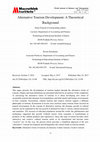
World Journal of Business and Management, 2017
This paper presents the development of tourism market through the alternative forms of tourism. O... more This paper presents the development of tourism market through the alternative forms of tourism. Origins and main definitions are presented followed by an analysis of the complexity of classifying the alternative forms of tourism. It is about developing new forms of sustainable tourism that integrate local populations and both natural and human environments of host countries. Ecotourism, cultural tourism and creative tourism support a different philosophy of tourism. Ecotourism in recent years encloses many tourism forms focused on natural environment. In the concept of alternative tourism, the dynamic growth of cultural tourism can be explained by the fast growth of demand for trips to various cultural attractions and amenities. Τhe increase of educated population around the world, the globalization and technology supported this growth. Cultural tourist, from consumer is transforming to producer of the cultural products and experiences. Since this type of tourist becomes more intera...
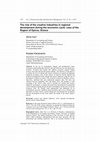
International Journal of Entrepreneurship and Innovation Management, 2017
In the era of extraordinary changes and globalisation, many researchers acknowledge that creativi... more In the era of extraordinary changes and globalisation, many researchers acknowledge that creativity and innovation are now driving the new economy. Countries and regions that embrace creativity generate higher revenue, more jobs and provide greater stability. The objective of this paper is to analyse the role of cultural and creative industries in regional development during the economic cycle. In this context, we map the current situation and needs for development of the cultural and creative industries using the case of the Region of Epirus in Greece. This research is based on literature reviews, interviews, statistical data and commercial register's data. The data was collected between September 2014 and March 2015. The database is built according to the NACE codes used to describe the cultural and creative industries. In the paper, we analyse the trend in the development of cultural and creative industries during the last decades with emphasis on the years of the last economic crisis. We identify main opportunities and challenges for its development, necessary conditions, main constraints and we try to outline main directions for future sector's growth taking into consideration the assumption that the development of this sector maybe the engine of the future region's growth.
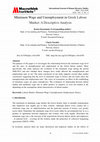
International Journal of Human Resource Studies, 2014
The purpose of this paper is to investigate the relationship between the minimum wage level and t... more The purpose of this paper is to investigate the relationship between the minimum wage level and the rates of unemployment and employment in the Greek labour market. More specifically, this study analyses the evolution of the minimum wage during the period 2000-2013 and also whether these changes have really affected the unemployment and employment rates or not. The main conclusion of our study supports several other studies conclusions suggesting that the level of minimum wage in Greece did not really affect the unemployment and employment rates. The views of economists on effect of the establishing of minimum wages are quite contradictory. The evaluation of relationship between labour market and minimum wage rate is either positive or negative or even not related at all, depending on the assumptions about characteristics of labour market.
Procedia - Social and Behavioral Sciences, 2015
Peer-review under responsibility of I-DAS-Institute for the Dissemination of Arts and Science.
Procedia - Social and Behavioral Sciences, 2015
Peer-review under responsibility of I-DAS-Institute for the Dissemination of Arts and Science.
Procedia - Social and Behavioral Sciences, 2015
Peer-review under responsibility of I-DAS-Institute for the Dissemination of Arts and Science.
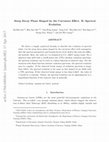
This paper explores the effects of liberalization in the Greek telecommunication market on pricin... more This paper explores the effects of liberalization in the Greek telecommunication market on pricing for the period 1992-2005. In particular, we examine the implications of privatization, competition and regulation in fixed telephony, mobile telephony and the internet markets and we investigate a) whether the sector’s reform influenced services pricing (descriptive analysis), b) the possible explanatory factors of these dependent variable (econometric analysis - Panel Feasible Generalised Least Squares – FGLS-). The data refers to 44 of the most prominent companies of fixed telephony, mobile telephony and internet services and was compiled by means of interviews with the help of a questionnaire. Our descriptive analysis concluded that liberalization of the telecommunication market induced price cuts. The main conclusion of econometric research is that a large market share provides in the companies the capability of cutting the prices of their services. In this way, the present article...
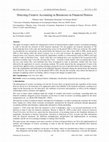
Accounting and Finance Research, 2019
This paper investigates whether the management of firms in financial distress applies creative ac... more This paper investigates whether the management of firms in financial distress applies creative accounting techniques in order to fine-tune the elements of their financial statements. For this purpose, the financial statements of 385 Greek bankrupt firms of the trade and manufacturing sectors for the period 2003 to 2014 were analyzed. The sample was divided into two sub periods; in the period before the financial crisis, that is from 2003 to 2008, and the period 2009 to 2014 during which the Greek economy was in crisis and recession. By applying factor analysis, five financial ratios were selected, which formed the independent variables in a Discriminant Analysis (MDA) and Logit models in order to find those firms which, while they were bankrupt they were classified in the last period of their operation as healthy (type I error).By selecting these firms (common to both models), their accounting data for the last two years before they went bankrupt have been investigated in order to...
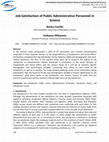
International Journal of Academic Research in Business and Social Sciences, 2013
In the present study participated a total of 67 permanent and contract administrators employed in... more In the present study participated a total of 67 permanent and contract administrators employed in three separate sections at the Greek Ministry of Employment and Social Affairs. Participants completed the Job Satisfaction Survey (Spector, 1985) and demographic and workrelated questions. The aims of the present study were (a) to measure the degree of job satisfaction of administrative officials employed in institutions of the Greek Ministry of Employment and Social Affairs and the various facets of it and (b) to examine specific demographic and work-related variables concerning their effect on each facet of job satisfaction as well as its totality. The study showed moderate levels of job satisfaction among participants. Age was found to be the only demographic variable to impact significantly on job satisfaction, while three facets of job satisfaction, one intrinsic (nature of work) and two extrinsic (supervision) and (co-workers) indicate high scores of job satisfaction.
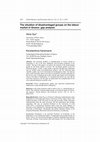
Global Business and Economics Review, 2019
The persistent problem of unemployment in Greece should be recognised as one of the most signific... more The persistent problem of unemployment in Greece should be recognised as one of the most significant socio-economic problems of the country. The aim of this paper is to analyse the situation of the disadvantaged groups on the labour market in Greece. We investigate patterns across the following groups: women, young people, long-term unemployed, immigrants and low skilled using cross-dimensional analysis with the following main variables: gender, age, level of education and immigration status. Our analysis relies on the European Labour Force Survey reported by Eurostat using data for the last ten years. Comparing the results with the main targets set by European Union in the field of employment, we concluded that Greece not only did not meet these objectives, but the gaps in employment and unemployment levels were explored during the economic crisis.
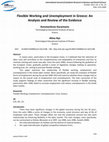
International Journal of Academic Research in Business and Social Sciences, 2014
In recent years, particularly in the European Union, it is believed that the reduction of labor c... more In recent years, particularly in the European Union, it is believed that the reduction of labor costs will contribute to the competitiveness and adaptability of enterprises and thus to maintain existing and create new jobs. Since the early 1990s, Greece following the guidelines of the European Union, gradually pushed a series of legislative changes relating to payments, working time, etc. aiming to promote flexible working. This paper examines the relationship of flexible working, employment and unemployment in the Greek labor market. More specifically, we study the evolution of flexible forms of employment during the period 2000-2013 and examine whether these changes had an impact on the overall scale of employment and unemployment. The main conclusion of the study supports findings of other researches that the significant increase in flexible working, particularly after 2009, failed to increase employment and reduce unemployment in the Greek labor market.
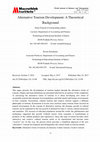
World Journal of Business and Management, 2017
This paper presents the development of tourism market through the alternative forms of tourism. O... more This paper presents the development of tourism market through the alternative forms of tourism. Origins and main definitions are presented followed by an analysis of the complexity of classifying the alternative forms of tourism. It is about developing new forms of sustainable tourism that integrate local populations and both natural and human environments of host countries. Ecotourism, cultural tourism and creative tourism support a different philosophy of tourism. Ecotourism in recent years encloses many tourism forms focused on natural environment. In the concept of alternative tourism, the dynamic growth of cultural tourism can be explained by the fast growth of demand for trips to various cultural attractions and amenities. Τhe increase of educated population around the world, the globalization and technology supported this growth. Cultural tourist, from consumer is transforming to producer of the cultural products and experiences. Since this type of tourist becomes more intera...
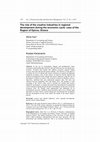
International Journal of Entrepreneurship and Innovation Management, 2017
In the era of extraordinary changes and globalisation, many researchers acknowledge that creativi... more In the era of extraordinary changes and globalisation, many researchers acknowledge that creativity and innovation are now driving the new economy. Countries and regions that embrace creativity generate higher revenue, more jobs and provide greater stability. The objective of this paper is to analyse the role of cultural and creative industries in regional development during the economic cycle. In this context, we map the current situation and needs for development of the cultural and creative industries using the case of the Region of Epirus in Greece. This research is based on literature reviews, interviews, statistical data and commercial register's data. The data was collected between September 2014 and March 2015. The database is built according to the NACE codes used to describe the cultural and creative industries. In the paper, we analyse the trend in the development of cultural and creative industries during the last decades with emphasis on the years of the last economic crisis. We identify main opportunities and challenges for its development, necessary conditions, main constraints and we try to outline main directions for future sector's growth taking into consideration the assumption that the development of this sector maybe the engine of the future region's growth.






Uploads
Papers by Kostas Karamanis
The purpose of this paper is to record important studies and to draw useful conclusions on the effects of structural changes in public utilities. As a case study the telecommunications markets will be analyzed, since in almost all developed and developing countries the telecommunication sector has experienced a transition process from a highly regulated stated –owned monopoly to a liberalized competitive market regime. In particular, the impacts of the privatization of the traditional organizations, introduction of competition and the establishment of an independent regulatory authority related to market performance indicators such as telephone penetration, amount of investments, prices and quality of service, employment and labor productivity, will be examined.
Rural women in modern Greek society play a multitude of social and economic roles in rural development and often represent a potential with a series of special abilities and skills which can be used for rural development.
Purpose of this field research is the study of the multifunctional role of rural women both in rural development and primary sector’s businesses. The survey was conducted in second semester of 2012, in Municipality of Pogoni, a remote area with increased importance in Prefecture of Ioannina – Region of Epirus, Greece – by personal interviews and questionnaire, containing closed and open-ended questions, with rural women aged 18-65 years, holding a small business in primary sector. Thus, results about entrepreneurship and female particularly are unique for this specific rural area.
Analyzing interviews’ results about women’s opinion concerning fields of agriculture, livestock, agritourism, etc., it is concluded that within modernization of primary sector, the role of rural women has greatly improved in production and organization of agricultural labor.
Female entrepreneurship networking (cooperatives, clustering), small businesses’ succession, and necessity and opportunity entrepreneurship in primary sector’s businesses are examined and also how these affect female entrepreneurship.
Women entrepreneurs’ opinions about their smes, E.U. measures, agriculture, quality of life in rural area, and their perspectives were catalogued.
Factors such as education and vocational training are important in enhancing the role of rural women.
Finally, main problems woman entrepreneur faces, mainly economic and managerial, were pointed out.
PTOs via public offer or direct sale have resulted in important changes in the organisational structure and operation of traditional telecommunication enterprises. These changes have attracted the attention of many studies, which can be categorised into two broad groups depending on the methodology applied: econometric analyses (panel data analysis) and case studies. The first group of investigations focuses on different aspects of PTOs, such as ownership structure of new enterprises, structure and functions of administration and labour issues. The second group of studies assess the impact of privatisation on business performance in terms of profitability, efficiency, production, investments, dividends, leverage, employment etc. The aim of the present study is to provide a comprehensive review of the existing relevant literature and to estimate the effect of privatisation on the corporate governance of telecommunication organisations.
In this way, the present article offers useful information about a field that continues to be characterized by a vast researching deficit.
The Chapter seeks to explain the relationship between employment - unemployment and flexible working in the Greek labour market. More specifically, we study the evolution of flexible forms of employment during the period 2000-2013 and examine whether these changes had an impact on the overall scale of employment and unemployment. In recent years, particularly in the European Union, it is believed that the reduction of labour costs will contribute to the competitiveness and adaptability of enterprises and thus to maintain existing and create new jobs. Since the early 1990s, Greece following the guidelines of the European Union, gradually pushed a series of legislative changes relating to wages, working time, etc. aiming to promote flexible working. The main conclusion of the study supports findings of other researches that the significant increase in flexible working, particularly after 2009, failed to increase employment and reduce unemployment in the Greek labour market.
This chapter is the comprehensive analysis of the views presented in the bibliography and provide a framework for substantive research presented in the next sections. Thus, the chapter tries to answer the following research questions: how are "creative industries" currently being defined, which are the main differences between creative and traditional industries, which are the most important political fields in the creative economy and who are their primary stakeholders. This chapter is also trying to analyze the concept of entrepreneurship in the creative industries and some characteristics of creative entrepreneurs which probably distinguish them from others sectors of activities. Which is the new model of work in the frame of this sector, what is the role of cultural diffusion and which are the main barriers to the future development of the creative and cultural industries sector are three other questions for which we will try to find an answer in this chapter.
Chapter 2 Abstract
This chapter reviews case study examples, of successful models and projects of transitioning from traditional industries to creative economies from other regions and countries. Because every country, region and city have its characteristics, the analysis presented in next chapters uses the presented case studies as framework guidelines and examples of what has been done in other locations and what can be done in the Region of Epirus. These case studies are used mainly to highlight the role that central and local governments play - across the world - to help regions transform into successful creative places and sustain the creative element over time. These lessons provide a guide to the type of the role that all levels of governments in the Region of Epirus may need to consider to adopt and to support a thriving creative economy in the medium and long term.
Chapter 3 Abstract
In this part is introduced the Region of Epirus in relation to the geography, economy and cultural profile of the region. In 2014 the region contributed to 2.8 per cent of the country's GDP. The Region of Epirus is one of the ecologically most valuable regions of Greece. The ecological importance of the area is coupled with the highly important anthropogenic traits, which include traditional agricultural landscapes and villages of traditional mountain architecture. Some important features of the region are vast and clean seacoasts, mountains, natural ecosystem, a variety of cultural monuments and heritage from one side and human capital, the tradition on the other. In this chapter of the study, the analysis of the region is carried out over time. Simultaneously the division of the region into smaller administrative units is presented. In this way, this chapter provides a background and all the necessary information for understanding the results of researches presented in the next section.
Chapter 4 Abstract
This part of the study describes the development of cultural and creative industries during the last decades with emphases on the years of the recent economic crisis. The data used in this part come from the Chambers of Epirus and were collected between September 2014 and December 2014. The database is built according to the NACE codes used to describe the cultural and creative industries and details presented in the report of The European Cluster Observatory "Priority Sector Report: Creative and Cultural Industries 2011" by Power D. The presentation of the cultural and creative enterprises is two-dimensional, the first dimension is the one of the Regional Units: (i) Regional Unit of Ioannina, (ii) Regional Unit of Arta, (iii) Regional Unit of Preveza and (iv) Regional Unit of Thesprotia. The second dimension refers to the enterprises' activity by sector. According to the data collected 2.8 per cent of the total number of the enterprises operating in 41 sectors of the creative and cultural industries in the four regional units of Epirus. Τhe evolution of cultural and creative enterprises in the Region from the eighties until today is also presented.
Chapter 5 Abstract
The aim of this chapter is a critical assessment of the cultural and creative industries in the Region of Epirus. This chapter is prepared using mainly information from interviews with the creative industry stakeholders. This target group, due to their role and professional experience, can provide information and visions useful to define the regional scenario of the creative industries' development. With the help of these data, a SWOT analysis is compiled. SWOT analyses try to identify: 1/. Strengths for the development of the cultural and creative industries in the Region of Epirus as key features that contribute to its long-time sustainability and competitiveness, 2/. Weaknesses as the absence of certain strengths or the presence of features that inhibit the ability of the industry to growth, 3/. Opportunities by which the cultural and creative industries can grow, 4/. Threats as the changes which may diminish the future industries' grow.
Chapter 6 Abstract
This chapter presents a review of the main themes of the book and some relevant recommendations for the development of creative and cultural industry in the region of Epirus in Greece. Among the major recommendations are those which are connected to the qualities of people and entrepreneurs, environment, cultural heritage, the role of the universities and schools, etc. The necessary conditions and existing constraints are described. Taking into account all above it is concluded to the main policy options which, according to our study should be concerned for proper regional development. The chapter also contains an admission of some of the issues and problems remain unsolved in this study, which can be viewed as directions for future researches.